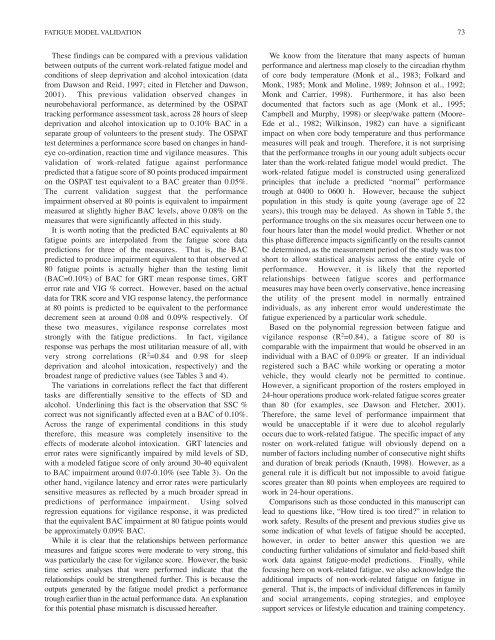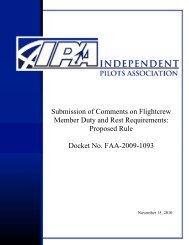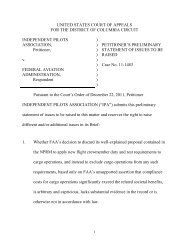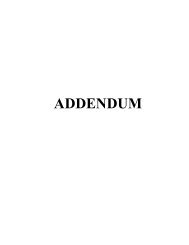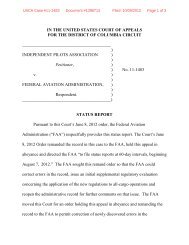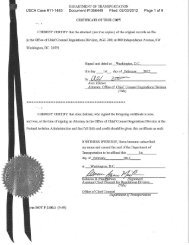Exhibits Vol 2 - Independent Pilots Association
Exhibits Vol 2 - Independent Pilots Association
Exhibits Vol 2 - Independent Pilots Association
Create successful ePaper yourself
Turn your PDF publications into a flip-book with our unique Google optimized e-Paper software.
FATIGUE MODEL VALIDATION<br />
73<br />
These findings can be compared with a previous validation<br />
between outputs of the current work-related fatigue model and<br />
conditions of sleep deprivation and alcohol intoxication (data<br />
from Dawson and Reid, 1997; cited in Fletcher and Dawson,<br />
2001). This previous validation observed changes in<br />
neurobehavioral performance, as determined by the OSPAT<br />
tracking performance assessment task, across 28 hours of sleep<br />
deprivation and alcohol intoxication up to 0.10% BAC in a<br />
separate group of volunteers to the present study. The OSPAT<br />
test determines a performance score based on changes in handeye<br />
co-ordination, reaction time and vigilance measures. This<br />
validation of work-related fatigue against performance<br />
predicted that a fatigue score of 80 points produced impairment<br />
on the OSPAT test equivalent to a BAC greater than 0.05%.<br />
The current validation suggest that the performance<br />
impairment observed at 80 points is equivalent to impairment<br />
measured at slightly higher BAC levels, above 0.08% on the<br />
measures that were significantly affected in this study.<br />
It is worth noting that the predicted BAC equivalents at 80<br />
fatigue points are interpolated from the fatigue score data<br />
predictions for three of the measures. That is, the BAC<br />
predicted to produce impairment equivalent to that observed at<br />
80 fatigue points is actually higher than the testing limit<br />
(BAC=0.10%) of BAC for GRT mean response times, GRT<br />
error rate and VIG % correct. However, based on the actual<br />
data for TRK score and VIG response latency, the performance<br />
at 80 points is predicted to be equivalent to the performance<br />
decrement seen at around 0.08 and 0.09% respectively. Of<br />
these two measures, vigilance response correlates most<br />
strongly with the fatigue predictions. In fact, vigilance<br />
response was perhaps the most utilitarian measure of all, with<br />
very strong correlations (R 2 =0.84 and 0.98 for sleep<br />
deprivation and alcohol intoxication, respectively) and the<br />
broadest range of predictive values (see Tables 3 and 4).<br />
The variations in correlations reflect the fact that different<br />
tasks are differentially sensitive to the effects of SD and<br />
alcohol. Underlining this fact is the observation that SSC %<br />
correct was not significantly affected even at a BAC of 0.10%.<br />
Across the range of experimental conditions in this study<br />
therefore, this measure was completely insensitive to the<br />
effects of moderate alcohol intoxication. GRT latencies and<br />
error rates were significantly impaired by mild levels of SD,<br />
with a modeled fatigue score of only around 30-40 equivalent<br />
to BAC impairment around 0.07-0.10% (see Table 3). On the<br />
other hand, vigilance latency and error rates were particularly<br />
sensitive measures as reflected by a much broader spread in<br />
predictions of performance impairment. Using solved<br />
regression equations for vigilance response, it was predicted<br />
that the equivalent BAC impairment at 80 fatigue points would<br />
be approximately 0.09% BAC.<br />
While it is clear that the relationships between performance<br />
measures and fatigue scores were moderate to very strong, this<br />
was particularly the case for vigilance score. However, the basic<br />
time series analyses that were performed indicate that the<br />
relationships could be strengthened further. This is because the<br />
outputs generated by the fatigue model predict a performance<br />
trough earlier than in the actual performance data. An explanation<br />
for this potential phase mismatch is discussed hereafter.<br />
We know from the literature that many aspects of human<br />
performance and alertness map closely to the circadian rhythm<br />
of core body temperature (Monk et al., 1983; Folkard and<br />
Monk, 1985; Monk and Moline, 1989; Johnson et al., 1992;<br />
Monk and Carrier, 1998). Furthermore, it has also been<br />
documented that factors such as age (Monk et al., 1995;<br />
Campbell and Murphy, 1998) or sleep/wake pattern (Moore-<br />
Ede et al., 1982; Wilkinson, 1982) can have a significant<br />
impact on when core body temperature and thus performance<br />
measures will peak and trough. Therefore, it is not surprising<br />
that the performance troughs in our young adult subjects occur<br />
later than the work-related fatigue model would predict. The<br />
work-related fatigue model is constructed using generalized<br />
principles that include a predicted “normal” performance<br />
trough at 0400 to 0600 h. However, because the subject<br />
population in this study is quite young (average age of 22<br />
years), this trough may be delayed. As shown in Table 5, the<br />
performance troughs on the six measures occur between one to<br />
four hours later than the model would predict. Whether or not<br />
this phase difference impacts significantly on the results cannot<br />
be determined, as the measurement period of the study was too<br />
short to allow statistical analysis across the entire cycle of<br />
performance. However, it is likely that the reported<br />
relationships between fatigue scores and performance<br />
measures may have been overly conservative, hence increasing<br />
the utility of the present model in normally entrained<br />
individuals, as any inherent error would underestimate the<br />
fatigue experienced by a particular work schedule.<br />
Based on the polynomial regression between fatigue and<br />
vigilance response (R 2 =0.84), a fatigue score of 80 is<br />
comparable with the impairment that would be observed in an<br />
individual with a BAC of 0.09% or greater. If an individual<br />
registered such a BAC while working or operating a motor<br />
vehicle, they would clearly not be permitted to continue.<br />
However, a significant proportion of the rosters employed in<br />
24-hour operations produce work-related fatigue scores greater<br />
than 80 (for examples, see Dawson and Fletcher, 2001).<br />
Therefore, the same level of performance impairment that<br />
would be unacceptable if it were due to alcohol regularly<br />
occurs due to work-related fatigue. The specific impact of any<br />
roster on work-related fatigue will obviously depend on a<br />
number of factors including number of consecutive night shifts<br />
and duration of break periods (Knauth, 1998). However, as a<br />
general rule it is difficult but not impossible to avoid fatigue<br />
scores greater than 80 points when employees are required to<br />
work in 24-hour operations.<br />
Comparisons such as those conducted in this manuscript can<br />
lead to questions like, “How tired is too tired” in relation to<br />
work safety. Results of the present and previous studies give us<br />
some indication of what levels of fatigue should be accepted,<br />
however, in order to better answer this question we are<br />
conducting further validations of simulator and field-based shift<br />
work data against fatigue-model predictions. Finally, while<br />
focusing here on work-related fatigue, we also acknowledge the<br />
additional impacts of non-work-related fatigue on fatigue in<br />
general. That is, the impacts of individual differences in family<br />
and social arrangements, coping strategies, and employee<br />
support services or lifestyle education and training competency.


